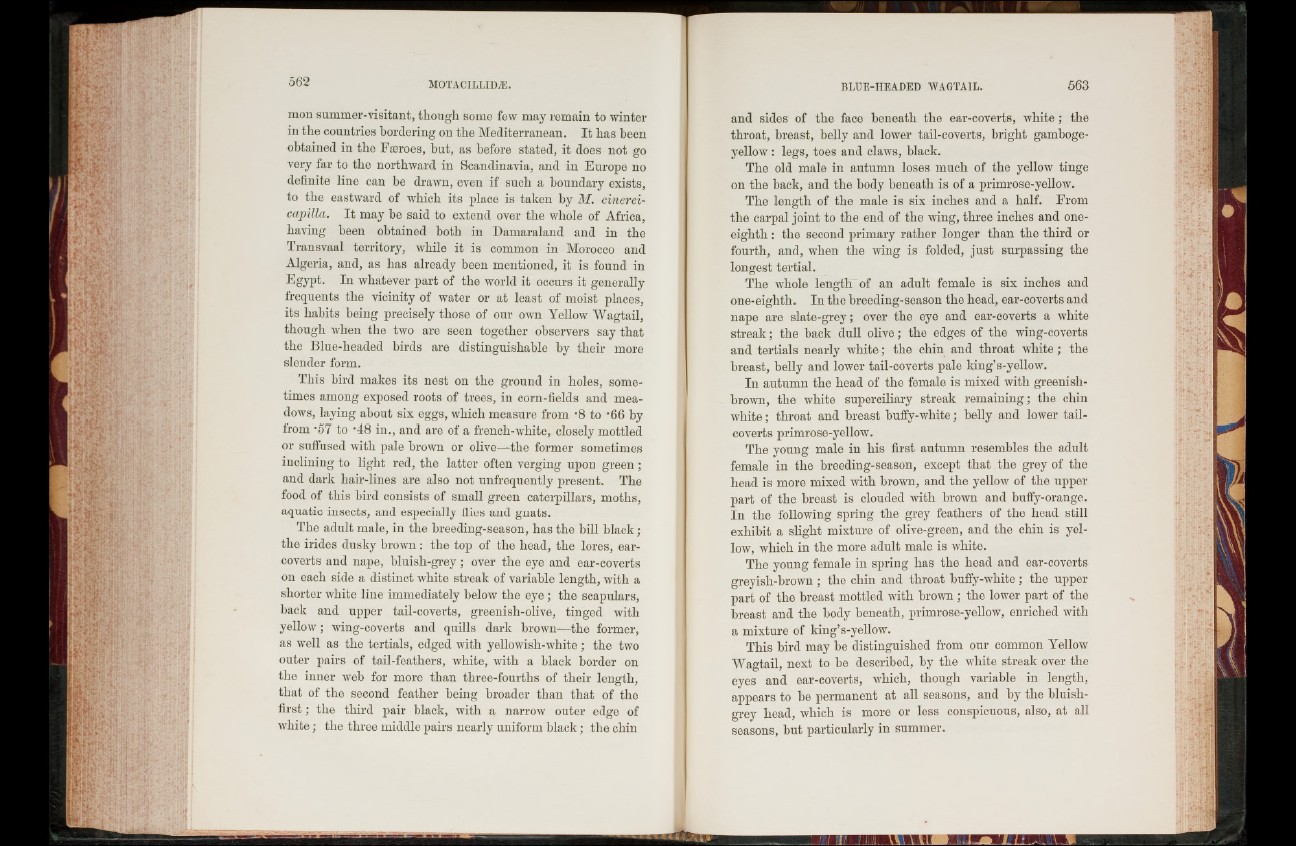
mon summer-visitant, though some few may remain to winter
in the countries bordering on the Mediterranean. I t has been
obtained in the Fteroes, but, as before stated, it does not go
very far to the northward in Scandinavia, and in Europe no
definite line can be drawn, even if such a boundary exists,
to the eastward of which its place is taken by M. cinerei-
capilla. I t may be said to extend over the whole of Africa,
having been obtained both in Damaraland and in the
Transvaal territory, while it is common in Morocco and
Algeria, and, as has already been mentioned, it is found in
Egypt. In whatever part of the world it occurs it generally
frequents the vicinity of water or at least of moist places,
its habits being precisely those of our own Yellow Wagtail,
though when the two are seen together observers say that
the Blue-headed birds are distinguishable by their more
slender form.
This bird makes its nest on the ground in holes, sometimes
among exposed roots of trees, in corn-fields and meadows,
laying about six eggs, which measure from -8 to ’66 by
from -57 to -48 in., and are of a french-wliite, closely mottled
or suffused with pale brown or olive—the former sometimes
inclining to light red, the latter often verging upon green;
and dark hair-lines are also not unfrequently present. The
food of this bird consists of small green caterpillars, moths,
aquatic insects, and esjjecially flies and gnats.
The adult male, in the breeding-season, has the bill black;
the irides dusky brown: the top of the head, the lores, ear-
coverts and nape, bluish-grey ; over the eye and ear-coverts
on each side a distinct white streak of variable length, with a
shorter white line immediately below the eye ; the scapulars,
back and upper tail-coverts, greenish-olive, tinged with
yellow; wing-coverts and quills dark brown—the former,
as well as the tertials, edged with yellowish-white ; the two
outer pairs of tail-feathers, white, with a black border on
the inner web for more than three-fourths of their length,
that of the second feather being broader than that of the
firs t; the third pair black, with a narrow outer edge of
white; the three middle pairs nearly uniform black; the chin
and sides of the face beneath the ear-coverts, white; the
throat, breast, belly and lower tail-coverts, bright gamboge-
yellow : legs, toes and claws, black.
The old male in autumn loses much of the yellow tinge
on the back, and the body beneath is of a primrose-yellow.
The length of the male is six inches and a half. From
the carpal joint to the end of the wing, three inches and one-
eightli : the second primary rather longer than the third or
fourth, and, when the wing is folded, just surpassing the
longest tertial.
The whole length of an adult female is six inches and
one-eighth. In the breeding-season the head, ear-coverts and
nape are slate-grey; over the eye and ear-coverts a white
streak; the back dull olive; the edges of the wing-coverts
and tertials nearly white; the chin and throat white; the
breast, belly and lower tail-coverts pale king’s-yellow.
In autumn the head of the female is mixed with greenish-
brown, the white superciliary streak remaining; the chin
white; throat and breast buffy-white; belly and lower tail-
coverts primrose-yellow.
The young male in his first autumn resembles the adult
female in the breeding-season, except that the grey of the
head is more mixed with brown, and the yellow of the upper
part of the breast is clouded with brown and buffy-orange.
In the following spring the grey feathers of the head still
exhibit a slight mixture of olive-green, and the chin is yellow,
which in the more adult male is white.
The young female in spring has the head and ear-coverts
greyisli-brown ; the chin and throat buffy-white ; the upper
part of the breast mottled with brown; the lower part of the
breast and the body beneath, primrose-yellow, enriched with
a mixture of king’s-yellow.
This bird may be distinguished from our common Yellow
Wagtail, next to be described, by the white streak over the
eyes and ear-coverts, which, though variable in length,
appears to be permanent at all seasons, and by the bluish-
grey head, which is more or less conspicuous, also, at all
seasons, but particularly in summer.